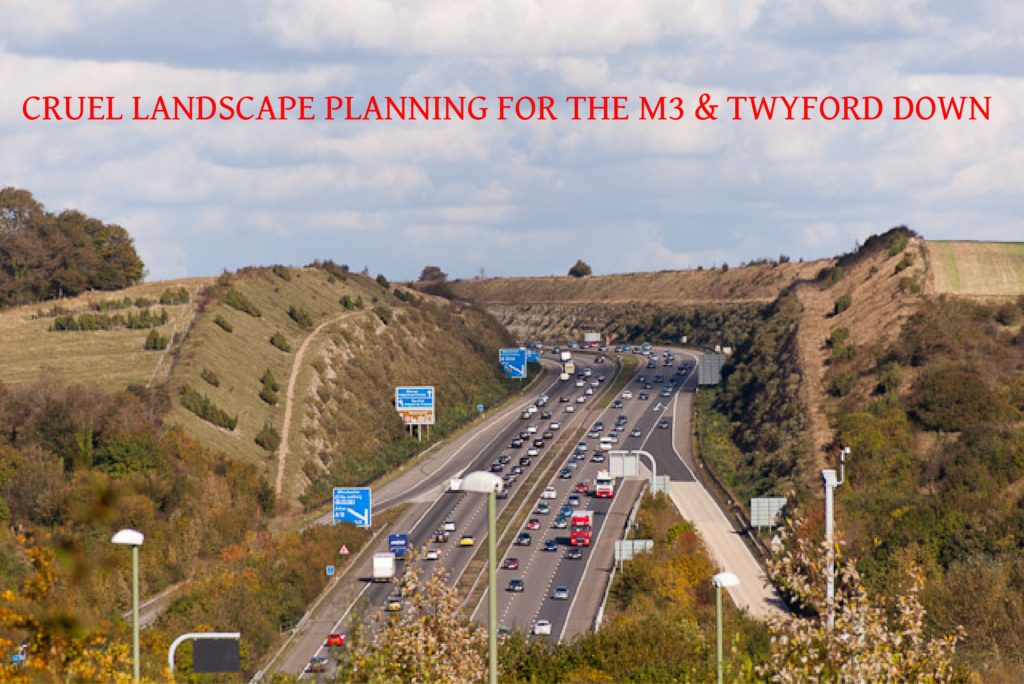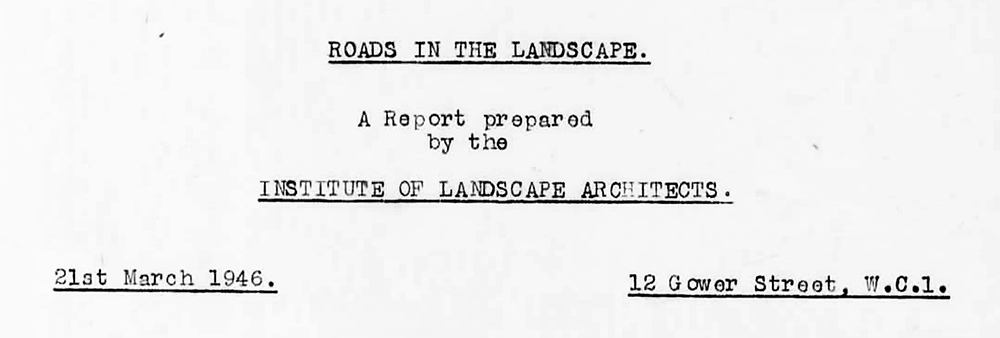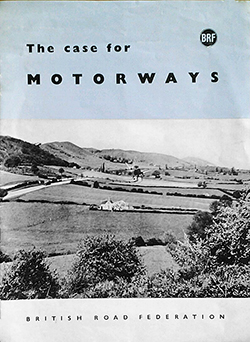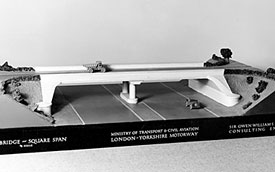The landscape architecture of highways
The current LI President spent eight years, as a volunteer, trying to protect Twyford Down from the M3 motorway. Merrick Denton-Thompson’s account of the Battle for Twyford Down is in the above video (8.48 to 21:20). It was lost and Barbara Bryant, a fellow protester who wrote a book about it asked: ‘And so, was it worth it? Yes, unhesitatingly yes. Winchester was worth it, Twyford Down was worth it, and our heritage is worth it. The desecration of Twyford Down was undoubtedly a tragedy.’ ‘The crucifixion was carried out by the UK Government in 1992’ (p.xi).

The Twyford Down Association was set up after the 1987 public inquiry. It challenged the government in the High Court for failing to implement the EC’s Environmental Impact Directive. The appeal failed but a further appeal to the European Commission succeeded. The UK was then faced with halting a large number of public works projects, including the Twyford Down cutting. To save the EC from bad publicity in the runup to the 1992 Maastricht Treaty, which created the European Union, a murky deal was done by Jacques Delors and John Major. The UK received an exemption from the EIA Directive and motorway works were allowed to proceed. Twyford then became ‘the launching ground for the direct action road protests of the 1990s’ and Swampy became a media star.
Landscape design for roads 1350 BCE to 1950 CE
- The Ancient World had royal roads (as in Amarna) and sacred ways (as from Athens to Delphi).
- The Romans held triumphal processions from the Campus Martius (outside the pomerium) and by way of the Porta Triumphalis, the Via Triumphalis, the Via Sacra, the Forum and the Capitoline Hill to the Temple of Jupiter.
- Avenues in Baroque gardens inspired radial town planning, with avenues, in Rome, Paris, Washington DC, Moscow and many other cities.
- Picturesque landscape parks included aesthetically planned serpentine roads and curvilinear tree-lined streets in public parks and nineteenth century cities.
- American parkways, designed by landscape architects Frederick Law Olmsted and others were designed as urban ’pleasure roads’ and as recreational routes, like the Blue Ridge Parkway. This led to the involvement of landscape architects in highway design.
- The Roads Beautifying Association (RBA) was founded by the UK Minister of Transport in 1928. Its emphasis was on planting ornamental trees and shrubs beside roads. The founder’s family estate in Wimborne St Giles had an important place in the history of landscape design dating from the 3rd Lord Shaftesbury.
UK landscape design and planning for roads 1950-present
- The ILA published two articles by American landscape architects on the landscape of roads and asserted ‘that the landscape architect, with his specialised knowledge of plants, trees and soils, and his training in design and construction, fills a gap between the architect and the town planner and adds to the value of both’.
- In 1946 the ILA published a booklet on Roads in the Landscape. It was probably written by Brenda Colvin and a revised edition was published by the Council for the Preservation of Rural England in 1954 as The Landscape treatment of roads

Roads in the Landscape was published by the Institute of Landscape Architects ILA in 1946. The Gower Street address is that of Geoffrey Jellicoe’s office but the report was probably written by Brenda Colvin - The UK Advisory Committee on the Landscape Treatment of Trunk Roads (also known as the Landscape Advisory Committee)

Geoffrey Jellicoe produced the photomontage on the cover of the BRF’s booklet on The case for motorways. His aim was to show that good landscape architecture roads could fit into landscape contexts was established in 1955 as a successor to the RBA and disbanded in 1994. Its terms of reference (in 1978) were to advise the Secretary of State on ‘alternative routes’ and ‘alternative standards’ while ‘having regard to the features and qualities of the landscape which would be affected and to other related environmental considerations’. The Advisory Committee was a QUANGO. It cost little to run and did some good work. But it was amateurish and unable to provide the professional advice required for large-scale infrastructure developments. The experts were volunteers who, when asked, could good company, good food and a coach trip to visit interesting countryside. Sylvia Crowe wrote to The Times about their work, in 1959. She was President of the ILA and was about to publish a book on the Landscape of Roads. Her comment was that the Landscape Advisory Committee was ‘no substitute for built-in professional advice’. Her book on The landscape of roads was published in 1960 (with illustrations by John Brookes).
- Crowe’s opinion of the Landscape Advisory Committee was confirmed by its inability to secure a satisfactory landscape design for the M1 in the 1950s and by it sanctioning the destruction of Twyford Down in the 1980s.
- Geoffrey Jellicoe published an essay on Motorways in 1960, explaining that it was based on the belief that ‘roads could and should add to the exhilaration of daily life, and that a long journey upon them could be a continuous and positive delight’. His conclusion was that ‘No rules or guidance in themselves ever produced a work of art. The professional trained in the arts is the only one ultimately qualified to design a landscape as a painter paints a picture… The great profession of civil engineers is courageous and audacious within its own field of physical works. We can be equally audacious in the arts. May the years before us bring forth a collaboration and a consequent scenery that will make the man on the road murmur to himself, “It’s good to be alive”’.
Landscape design for the M1 Motorway

Sir Owen Williams became chief engineer for the first section of the M1. Also a brilliant architect, he asked the Institute of Landscape Architects to recommend landscape consultants for Britain’s first motorway. ‘After discovering the high fees recommended by the ILA, the Ministry decided that the consulting engineers should employ their own consultants’. They chose two foresters (Archibald Long and AJM Clay) who are unlikely to have been asked about the road alignment or the much-criticised design of the bridges. Brenda Colvin said the bridges ‘were very heavy in design’ and the embankments had ‘hard sharp lines and clumsy angles’ . The planting was also challenged. ‘Sir Eric Savill questioned the proposals to plant forsythia and pyracantha, while Sir David Bowes-Lyon and the whole committee ‘agreed that flowering plants of a semi-garden character were misplaced in real countryside’. The Landscape Advisory Committee, to its credit, was highly critical of the landscape treatment of the M1.
European EIA Directive
The European Commission’s Environmental Impact Assessment Directive ( EIA Directive (85/337/EEC)) has led to more involvement of landscape architects in road projects but the results of their involvement are themselves in need of assessment. It could be done under the auspices of the Landscape Institute or the Department for Transport. I hope I am wrong but my impression is that more effort goes into Environmental Impact Assessment (EIA) than into Environmental Impact Design (EID) or the matters within the Landscape Advisory Committee’s brief.
Conclusion
UK government policy on the landscape planning and design of roads has been penny-wise and pound-foolish. A relatively trivial expenditure on expert landscape advice would have produced better roads at less cost on a shorter timescale. One can understand the government’s wish to be frugal but shoddy workmanship does not save money.
